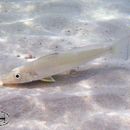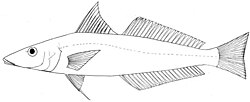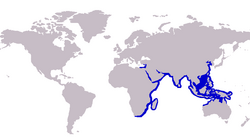en
names in breadcrumbs


Die Silwer sillago (Sillago sihama) is 'n vis wat voorkom in die Indiese-Pasifiese area, die Rooisee, die Persiese Golf, die Comore, Madagaskar en aan die ooskus van Suid-Afrika suidwaarts tot by Knysna. In Engels staan die vis bekend as die Silver sillago.
Die vis se kop en lyf is silwerig met 'n goue tint en die vinne is deurskynend. Die vis word tot 35 cm groot.
Die vis verkies beskermde water met sanderige bodems om in te leef. Hulle eet wurms en skaaldiere. Die vis kom in skole voor.
Die Silwer sillago (Sillago sihama) is 'n vis wat voorkom in die Indiese-Pasifiese area, die Rooisee, die Persiese Golf, die Comore, Madagaskar en aan die ooskus van Suid-Afrika suidwaarts tot by Knysna. In Engels staan die vis bekend as die Silver sillago.
Sillago sihama és una espècie de peix de la família Sillaginidae i de l'ordre dels perciformes.
Els mascles poden assolir els 31 cm de longitud total.[2]
Es troba des del Mar Roig fins a Sud-àfrica, Japó, Austràlia i Nova Caledònia. També present a la Mediterrània (Turquia).[2]
Sillago sihama és una espècie de peix de la família Sillaginidae i de l'ordre dels perciformes.
The northern whiting (Sillago sihama), also known as the silver whiting and sand smelt, is a marine fish, the most widespread and abundant member of the smelt-whiting family Sillaginidae. The northern whiting was the first species of sillaginid scientifically described and is therefore the type species of both the family Sillaginidae and the genus Sillago. The species is distributed in the Indo-Pacific region from South Africa in the west to Japan and Indonesia in the east, also becoming an invasive species to the Mediterranean through the Suez Canal. The northern whiting inhabits coastal areas to 60 m, but is most often found in shallow water around bays and estuaries, often entering freshwater. It is a carnivore, taking a variety of polychaetes and crustaceans. The species is of major economic importance throughout the Indo-Pacific. It is most frequently taken by seine nets and cast nets and marketed fresh.
The northern whiting is one of 29 species in the genus Sillago, which is one of three genera in the smelt-whiting family Sillaginidae. The smelt-whitings are Perciformes in the suborder Percoidea.[1]
The northern whiting was first described by Peter Forsskål in 1775 under the name Atherina sihama, mistaking the fish as a species of hardyhead. The species was subsequently placed in the genus Platycephalus, before its true identity as a new genus was realized and Sillago was created in 1816.[2] This was the first description and naming of any smelt-whiting, even though the author initially placed the species in the wrong genus. This makes S. sihama the type species of its genus, Sillago, as well as the type species of the family Sillaginidae, which was not to be named until 1846. However, Forsskål's name was not the only one applied to the species, with three other names given to the fish after the first correct naming. Two of these, S. acuta and S. erythraea were made by Georges Cuvier, and the other, Sciaena malabarica by Bloch and Schneider. These later names are junior synonyms and are discarded under the ICZN rules.[2] Due to its wide distribution, the species has been applied a number of common names, with northern whiting, silver whiting, sand smelt and silver sillago the most common English names.[3]
The northern whiting's similarity to all other species in the genus Sillago has led to many less abundant species being confused with it. The species is known to grow to a maximum size of 31 cm,[4] however reports dating back to 1850 in Bengal suggest the species attains 3 feet (91 cm), which would make it the largest species of sillaginid.[5] These reports were never etched into the literature on the species, possibly because of presumed confusion with the similar but unrelated and larger milkfish and bonefish that inhabit the area. The species has a slightly compressed, elongate body tapering toward the terminal mouth. The dorsal fin is in two parts, the first made of feeble spines and the second of soft rays headed by a single feeble spine, while the ventral profile is straight.[6]
The fin anatomy is highly useful for identification purposes, with the species having 11 spines in the first dorsal fin, with one spine and 20 to 23 soft rays on the second dorsal fin. The anal fin has two spines with 21 to 23 soft rays posterior to the spines. Lateral line scales and cheek scales are also distinctive, with northern whiting possessing 66 to 72 lateral line scales and cheek scales positioned in 3–4 rows, all of which are ctenoid. The amount of vertebrae are also diagnostic, having 34 in total. The swim bladder is the most accurate diagnostic feature, having two posterior extensions and two anterior extensions. The two anterior extensions extend forward and diverge to end on each side of the basioccipital above the auditory capsule. Two lateral extensions also commence anteriorly, each of them sending a blind tubule anterolaterally and then extending along the abdominal wall. The lateral extensions are normally convoluted and have blind tubules arising along their length. The two posterior tapering extensions project into the caudal region, with one usually longer than the other.[2]
The colour of the body is variable, often being light tan, silvery yellow-brown, sandy brown, or honey coloured. The underside of the fish is usually paler, being brown to white in colour. A silver midlateral, longitudinal stripe is normally present. The dorsal fins are dusky on each end, with or without rows of dark brown spots on the second dorsal fin membranes. The caudal fin is dusky terminally, and there is no dark blotch at the base of the pectoral fin as in other sillaginids. All other fins are hyaline, but the anal fin occasionally has a whitish margin.[4]
The northern whiting is the most geographically widespread of the Sillaginidae, but is still confined to the Indian and Western Pacific Oceans. Its easternmost range is from South Africa north along the west coast of Africa and into the Red sea and Persian Gulf.[3] It is common along the Indian and Asian coast, extending to Taiwan and has been recorded in Japan, however these likely are confused with S. japonica.[7] It is common throughout the Indonesian Archipelago, the Philippines and extends as far south as northern Australia.[8] The species has been declared an invasive species to the eastern Mediterranean, passing through the Suez Canal from the Red Sea since 1977 as part of the Lessepsian migration, becoming widespread.[9]
The northern whiting is primarily an inshore species, rarely seen in depth of more than 20 m. It commonly inhabits both high energy beaches and sandbars as well as more protected bays along mangrove creeks and tidal flats. The species commonly enters estuaries, and has even been recorded in freshwater, despite the fact it has no anatomical adaptations to cope with this change. The northern whiting does not migrate or move offshore at various times of the year like some co-occurring sillaginids.[10]
Like most members of the family, S. sihama can bury itself in the sand when danger approaches and commonly avoids seine-nets by employing this behaviour, giving them the common name 'sandborer' in some countries.
The principal items of diet are polychaete worms, small prawns and copepods,[11] with other Crustacea including Decopoda,[12] Ocypoda, shrimps, and amphipods also taken. Small fish are often taken and filamentous algae is consumed. Australian specimens frequently contain polychaete worms and small Crustacea. The species often has a similar, but slightly different diet compared to other coexisting sillaginids and other fishes,[11] with few cases of wide dietary overlap recorded. The juveniles and adults also show disparity in their diets, with juveniles taking zooplankton such as copepods, while adults take larger crustaceans and polychaetes.[13]
Northern whiting reach sexual maturity at a minimum 106 mm in males and 117 mm in females, although most individuals from both sexes mature once they reach 130 mm in length and one year of age.[14] Growth in the species is rapid, attaining a length of 13 to 14 cm at about 1 year, 16 to 20 cm at 2 years, 20 to 24 cm at 3 years and 24 to 28 cm by 4 years of age.[15]
Spawning occurs year-round, but a peak of spawning activity occurs once during the year at variable times over the species range. Peak of spawning in Thailand is August and November,[14] November to April in the Philippines,[10] November to March in India,[16] and between July and February with a peak in November in Sri Lanka.[17] The egg is spherical, colourless and buoyant, 0.5 to 0.6 mm in diameter, and without a large oil globule.[18] Fecundity varied between 16 682 and 166 130.[4] The eggs and larval development of S. sihama has been extensively described separately by Bensam and Kato et al., with the distinguishing feature of the larvae being the pattern of melanophores distributed on the caudal fin base, having these in a vertical line.[10][19]
Considerable catches of northern whiting are made but generally not reflected in the fishery statistics of countries they are taken in. In Pakistan the main fishery takes place in June to July. The catches reported in this single country range from 102 t (1980) to 859 t (1982) with an average of 404 t.[4] The species has come under heavy threat in Chinese waters from overfishing and environmental pollution.[20]
The northern whiting (Sillago sihama), also known as the silver whiting and sand smelt, is a marine fish, the most widespread and abundant member of the smelt-whiting family Sillaginidae. The northern whiting was the first species of sillaginid scientifically described and is therefore the type species of both the family Sillaginidae and the genus Sillago. The species is distributed in the Indo-Pacific region from South Africa in the west to Japan and Indonesia in the east, also becoming an invasive species to the Mediterranean through the Suez Canal. The northern whiting inhabits coastal areas to 60 m, but is most often found in shallow water around bays and estuaries, often entering freshwater. It is a carnivore, taking a variety of polychaetes and crustaceans. The species is of major economic importance throughout the Indo-Pacific. It is most frequently taken by seine nets and cast nets and marketed fresh.
Sillago sihama es una especie de peces de la familia Sillaginidae en el orden de los Perciformes.
Los machos pueden llegar alcanzar los 31 cm de longitud total.[1]
Se encuentra desde el Mar Rojo hasta Sudáfrica, Japón, Australia y Nueva Caledonia. También presente en el Mediterráneo (Turquía ).
Sillago sihama es una especie de peces de la familia Sillaginidae en el orden de los Perciformes.
Sillago sihama Sillago generoko animalia da. Arrainen barruko Sillaginidae familian sailkatzen da.
Espezie hau honako ekosistematan aurki daiteke:
Sillago sihama Sillago generoko animalia da. Arrainen barruko Sillaginidae familian sailkatzen da.
Ikan Bulus atau nama saintifiknya Sillago sihama merupakan ikan air masin. Ia juga dikenali sebagai ikan Puntung-Damar Perak.[1]
Ia merupakan ikan yang penting secara komersial dan dijual di pasar-pasar sebagai makanan. Penangkapannya memerlukan lesen bagi memastikan ia tidak terancam oleh tangkapan melampau oleh nelayan komersial.[2].
Ikan Bulus atau nama saintifiknya Sillago sihama merupakan ikan air masin. Ia juga dikenali sebagai ikan Puntung-Damar Perak.
Ia merupakan ikan yang penting secara komersial dan dijual di pasar-pasar sebagai makanan. Penangkapannya memerlukan lesen bagi memastikan ia tidak terancam oleh tangkapan melampau oleh nelayan komersial..
De zilversillago (Sillago sihama) is een straalvinnige vissensoort uit de familie van witte baarzen (Sillaginidae).[1] De wetenschappelijke naam van de soort is voor het eerst geldig gepubliceerd in 1775 door Peter Forsskål.
Bronnen, noten en/of referenties
Sillago sihama er den mest utbredte og tallrike arten av sandabborer. Fisket etter denne arten har stor økonomisk betydning i hele det indopasifiske området.
Sillago sihama er den mest utbredte og tallrike arten av sandabborer. Fisket etter denne arten har stor økonomisk betydning i hele det indopasifiske området.
Sillago sihama, tại Việt Nam còn có tên là cá đục[1], là một loài cá biển trong họ Sillaginidae. Loài này phân bố ở khu vực Ấn Độ-Thái Bình Dương từ Nam Phi ở phía tây Nhật Bản và Indonesia ở phía đông, cũng trở thành một loài xâm lấn đến Địa Trung Hải qua kênh đào Suez. Chúng sinh sống ở vùng ven biển đến 60 m, nhưng thường được tìm thấy trong vùng nước nông xung quanh vịnh và cửa sông, thường vào nước ngọt. Đó là một động vật ăn thịt, ăn nhiều loại giun nhiều tơ và động vật giáp xác. Loài cá này có tầm quan trọng kinh tế lớn trên khắp Ấn Độ-Thái Bình Dương.
Sillago sihama, tại Việt Nam còn có tên là cá đục, là một loài cá biển trong họ Sillaginidae. Loài này phân bố ở khu vực Ấn Độ-Thái Bình Dương từ Nam Phi ở phía tây Nhật Bản và Indonesia ở phía đông, cũng trở thành một loài xâm lấn đến Địa Trung Hải qua kênh đào Suez. Chúng sinh sống ở vùng ven biển đến 60 m, nhưng thường được tìm thấy trong vùng nước nông xung quanh vịnh và cửa sông, thường vào nước ngọt. Đó là một động vật ăn thịt, ăn nhiều loại giun nhiều tơ và động vật giáp xác. Loài cá này có tầm quan trọng kinh tế lớn trên khắp Ấn Độ-Thái Bình Dương.

白沙鮻(学名:Sillago sihama),又名多鳞鱚,为鱚科鱚属的鱼类。分布于红海、非洲东岸、澳洲、印度、印度尼西亚、菲律宾、朝鲜、日本以及中国南海、东海及黄渤海等海域。该物种的模式产地在红海。[1]
 分類 界 : 動物界 Animalia 門 : 脊索動物門 Chordata 亜門 : 脊椎動物亜門 Vertebrata 綱 : 条鰭綱 Actinopterygii 目 : スズキ目 Perciformes 科 : キス科 Sillaginidae 属 : キス属 Sillago 種 : モトギス S. sihama 学名 Sillago sihama
分類 界 : 動物界 Animalia 門 : 脊索動物門 Chordata 亜門 : 脊椎動物亜門 Vertebrata 綱 : 条鰭綱 Actinopterygii 目 : スズキ目 Perciformes 科 : キス科 Sillaginidae 属 : キス属 Sillago 種 : モトギス S. sihama 学名 Sillago sihama
モトギス (Sillago sihama) はキス科に属する海水魚である。キス科の中では最も広範囲に分布する普遍的な種で、キス科・キス属の中で最初に記載されたタイプ種である。インド太平洋に分布し、西は南アフリカから東は日本・インドネシアまで見られる。また、スエズ運河を通じて地中海にも侵入している。湾内・河口などの浅海に生息し、淡水で見られることもある。肉食性で、様々な多毛類・甲殻類を食べる。漁業上の重要種で、底引き網や投げ網で漁獲されて販売される。
キス属に属するおよそ30種中の1種である[1]。1775年、Peter Forsskålは本種をトウゴロウイワシ類とみなし、Atherina sihama の名で記載した。その後本種はコチ属に移され、1816年に新しくSillago 属が設立されるまではそのままであった[2]。最初に学名の付けられたキス類であり、キス科 Sillaginidaeのタイプ種でもあるが、この科の設立は1846年のことである。本種がSillago sihama と命名された後も、3回の命名が独立に行われている。2回はジョルジュ・キュヴィエによるS. acutaと S. erythraeaで、もう一つはBlochとSchneiderによる Sciaena malabarica である。後者はジュニアシノニムで、ICZNでは認められない[2]。分布が広いため多くの名がある。英名としてはnorthern whiting・silver whiting・sand smelt・silver sillagoなどがある[3]。
キス属の種は互いに似ているため、本種はよく他種と混同されてきた。最大で31 cmになる[4]。1850年のベンガルで3フィートの個体の報告があるが[5]、これは同所に生息するサバヒーやソトイワシと混同したものとみられ、公式には認められていない。
体は僅かに側扁して細長く、口は先細りとなっている[6]。第一背鰭は11棘条、第二背鰭は1棘20-23軟条。臀鰭は2棘21-23軟条。側線鱗数は66-72、頬鱗は3–4列。鱗は櫛鱗である。脊椎骨数は合計34。鰾による同定が最も確実で、前方から2対、後方から1対の突起が伸びている。前方の突起は前に伸び、基後頭骨の側面、耳殻の上方で終わっている。もう1対の突起は側方から伸びて二分し、片方は腹壁に沿って前に伸びる盲管となり、もう片方は入り組んだ盲管となって後方へ伸びる。後方の突起は先細りに尾の方へ向かい、通常は片方がより長い[2]。
体色は様々で、淡褐色・銀色がかった黄褐色・赤褐色など。腹面は淡い色で、褐色から白。大抵、体側には銀色の縦縞がある。背鰭の縁はくすんだ色で、第二背鰭には褐色の斑点があることもある。尾鰭の端は暗く、他のキスと違って胸鰭の根本が黒くなることはない。他の鰭は半透明だが、臀鰭の縁は白くなることがある[4]。
キス科で最も広範囲に分布する種で、インド太平洋で見られる。東は南アフリカからアフリカ西岸、紅海、ペルシャ湾[3]、アジアでは日本・台湾まで見られるが、シロギスと混同されている可能性もある[7]。インドネシア・フィリピンでは全域、南はオーストラリア北部にまで生息する[8]。本種はレセップス移動(英語版)の一部として紅海からスエズ運河を抜けて東地中海に侵入している。最初に記録されたのは1977年で、外来種とみなされている[9]。
主に浅海性で、20 m以深で見られることは少ない。主に開放性の砂浜・砂州、またはマングローブ帯や干潟に生息する。特別に低塩分濃度に適応した構造があるわけではないが、河口や淡水域でもよく見られる。他のキス類とは違い、一年中沖合に移動することはない[10]。
他のキス類のように、危険を避けるために砂に潜ることができる。この行動で底引き網を避けることもあり、いくつかの国では'sandborer'と呼ばれている。
主に多毛類、小型のクルマエビ、カイアシを餌とするが[11]、スナガニ・小エビ・端脚類などの他の甲殻類も食べる[12]。小魚や糸状の藻類を食べることもある。オーストラリアの個体は多毛類・小型甲殻類を食べている。共存するキス類や他の魚種と食性はほぼ同じだが、わずかに構成が異なる場合もある[11]。稚魚と成魚でも食物に差があり、稚魚は主にカイアシのような動物プランクトン、成魚は主に大型の甲殻類・多毛類が餌となる[13]。
最小で、雄で106 mm・雌で117 mmで性成熟するが、一般的には1歳、130 mm程度である[14]。成長は早く、1年で13-14 cm、2年で16-20 cm、3年で20-24 cm、4年で24-28 cmになる[15]。
繁殖は一年中行われるが、ピークの時期は生息地によって変化する。タイでは8-11月[14]、フィリピンでは11-4月[10]、インドでは11-3月[16]。スリランカでは7-2月に繁殖が行われ、ピークは11月である[17]。卵は浮性卵で、球形・無色。直径0.5-0.6mmで大きな油滴はない[18]。産卵数は16,682-166,130[4]。発生過程はBensamとKato et al.によって詳しく記録されている。幼生の特徴としては、尾鰭付け根の黒色素胞が縦に並ぶことが挙げられる[10][19]。
かなりの漁獲量があると考えられるが、一般的に国家の漁業統計には反映されていない。パキスタンでは主に6-7月に漁獲され、年間102 t (1980年) から 859 t (1982年) でこの間の平均は404 tであった[4]。中国沿岸では乱獲と環境汚染によって危機に瀕している[20]。
モトギス (Sillago sihama) はキス科に属する海水魚である。キス科の中では最も広範囲に分布する普遍的な種で、キス科・キス属の中で最初に記載されたタイプ種である。インド太平洋に分布し、西は南アフリカから東は日本・インドネシアまで見られる。また、スエズ運河を通じて地中海にも侵入している。湾内・河口などの浅海に生息し、淡水で見られることもある。肉食性で、様々な多毛類・甲殻類を食べる。漁業上の重要種で、底引き網や投げ網で漁獲されて販売される。
보리멸(영어: northern whiting)은 보리멸과의 물고기이다. 몸길이 24cm 가량으로 몸은 앞쪽은 원통형, 뒤쪽은 측편하고 주둥이는 길고 끝이 뾰족하다. 몸빛은 등쪽이 담황색, 배는 그보다 밝다. 등지느러미는 두 개이고 비늘은 작고 쉽게 벗겨진다. 내만성 물고기로 해안 근처 모래 바닥에 살면서 새우 등의 작은 갑각류나 갯지렁이를 잡아먹는다. 큰 먹이는 작은 이로 이리저리 흔들어 물어뜯어 먹는다. 산란기는 6-9월경이며, 염분 농도가 낮은 내만으로 와서 알을 낳는다. 한국에서는 황해 남부와 동해 남부에 서식하며, 일본 남부에서 중국·타이완·필리핀·인도네시아·아라비아 해·홍해까지 분포한다. 원피스의 등장인물에서 츄가 보리멸 어인이고, 시라호시는 보리멸 인어로 등장한다.